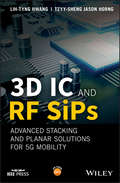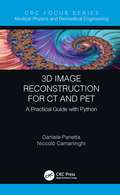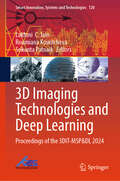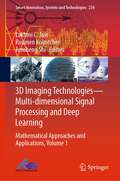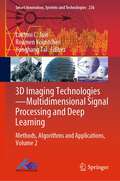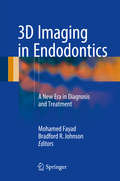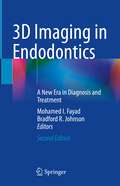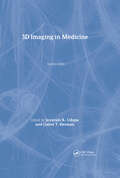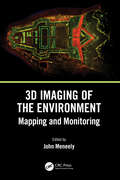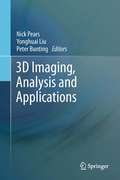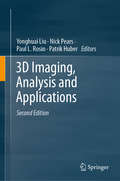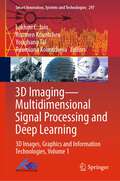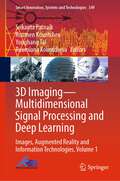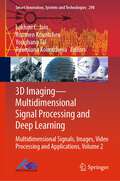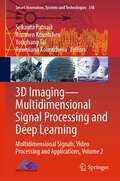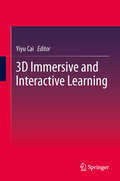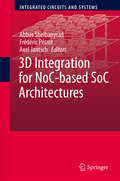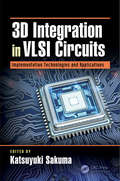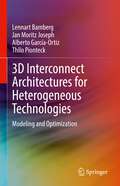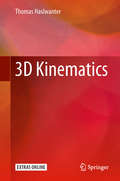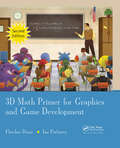- Table View
- List View
3D Histology Evaluation of Dermatologic Surgery
by Patrick Adam Helmut BreuningerThere hasn't been a book concerning "Microscopically Controlled Surgery" published and it is vital to publish a book that details all the different terms and methodology used in microscopically controlled surgery. The goal is to create a practical, concise and simple explanation of 3D-histology with workflows and detailed illustrative material for dermatologists. It is therefore designed to be a goal-oriented manual rather than an exhaustive reference work. It will provide the essential information for all working with patients undergoing this group of treatments.
3D IC and RF SiPs: Advanced Stacking And Planar Solutions For 5g Mobility (Wiley - IEEE)
by Lih-Tyng Hwang Tzyy-Sheng Jason HorngAn interdisciplinary guide to enabling technologies for 3D ICs and 5G mobility, covering packaging, design to product life and reliability assessments Features an interdisciplinary approach to the enabling technologies and hardware for 3D ICs and 5G mobility Presents statistical treatments and examples with tools that are easily accessible, such as Microsoft’s Excel and Minitab Fundamental design topics such as electromagnetic design for logic and RF/passives centric circuits are explained in detail Provides chapter-wise review questions and powerpoint slides as teaching tools
3D Image Reconstruction for CT and PET: A Practical Guide with Python (Focus Series in Medical Physics and Biomedical Engineering)
by Daniele Panetta Niccolo CamarlinghiThis is a practical guide to tomographic image reconstruction with projection data, with strong focus on Computed Tomography (CT) and Positron Emission Tomography (PET). Classic methods such as FBP, ART, SIRT, MLEM and OSEM are presented with modern and compact notation, with the main goal of guiding the reader from the comprehension of the mathematical background through a fast-route to real practice and computer implementation of the algorithms. Accompanied by example data sets, real ready-to-run Python toolsets and scripts and an overview the latest research in the field, this guide will be invaluable for graduate students and early-career researchers and scientists in medical physics and biomedical engineering who are beginners in the field of image reconstruction. A top-down guide from theory to practical implementation of PET and CT reconstruction methods, without sacrificing the rigor of mathematical background Accompanied by Python source code snippets, suggested exercises, and supplementary ready-to-run examples for readers to download from the CRC Press website Ideal for those willing to move their first steps on the real practice of image reconstruction, with modern scientific programming language and toolsets Daniele Panetta is a researcher at the Institute of Clinical Physiology of the Italian National Research Council (CNR-IFC) in Pisa. He earned his MSc degree in Physics in 2004 and specialisation diploma in Health Physics in 2008, both at the University of Pisa. From 2005 to 2007, he worked at the Department of Physics "E. Fermi" of the University of Pisa in the field of tomographic image reconstruction for small animal imaging micro-CT instrumentation. His current research at CNR-IFC has as its goal the identification of novel PET/CT imaging biomarkers for cardiovascular and metabolic diseases. In the field micro-CT imaging, his interests cover applications of three-dimensional morphometry of biosamples and scaffolds for regenerative medicine. He acts as reviewer for scientific journals in the field of Medical Imaging: Physics in Medicine and Biology, Medical Physics, Physica Medica, and others. Since 2012, he is adjunct professor in Medical Physics at the University of Pisa. Niccolò Camarlinghi is a researcher at the University of Pisa. He obtained his MSc in Physics in 2007 and his PhD in Applied Physics in 2012. He has been working in the field of Medical Physics since 2008 and his main research fields are medical image analysis and image reconstruction. He is involved in the development of clinical, pre-clinical PET and hadron therapy monitoring scanners. At the time of writing this book he was a lecturer at University of Pisa, teaching courses of life-sciences and medical physics laboratory. He regularly acts as a referee for the following journals: Medical Physics, Physics in Medicine and Biology, Transactions on Medical Imaging, Computers in Biology and Medicine, Physica Medica, EURASIP Journal on Image and Video Processing, Journal of Biomedical and Health Informatics.
3D Image Technologies, Robotics and Control Engineering: Proceedings of WCI3DT 2024 (Smart Innovation, Systems and Technologies #419)
by Lakhmi C. Jain Srikanta Patnaik Wenfeng Wang Roumiana KountchevaThis book features a collection of high-quality, peer-reviewed research papers presented at Third 'World Conference on Intelligent and 3D Technologies' (WCI3DT 2024), held in China during May 24–26, 2024. The book provides an opportunity to researchers and academia as well as practitioners from industry to publish their ideas and recent research development work on all aspects of 3D imaging technologies and artificial intelligence, their applications and other related areas. The book presents ideas and the works of scientists, engineers, educators and students from all over the world from institutions and industries.
3D Imaging Technologies and Deep Learning: Proceedings of the 3DIT-MSP&DL 2024 (Smart Innovation, Systems and Technologies #120)
by Lakhmi C. Jain Srikanta Patnaik Roumiana KountchevaThis book presents high-quality research in the field of 3D imaging technology. The sixth edition of International Conference on 3D Imaging Technology (3DDIT-MSP&DL 2024) continues the good traditions already established by the first five editions of the conference to provide a wide scientific forum for researchers, academia, and practitioners to exchange newest ideas and recent achievements in all aspects of image processing and analysis, together with their contemporary applications. The conference proceedings are published in two volumes. The main topics of the papers comprise famous trends as: 3D image representation, 3D image technology, 3D images and graphics, and computing and 3D information technology. In these proceedings, special attention is paid at the 3D tensor image representation, the 3D content generation technologies, big data analysis, and deep learning, artificial intelligence, the 3D image analysis and video understanding, the 3D virtual and augmented reality, and many related areas. The first volume contains papers in 3D image processing, transforms, and technologies. The second volume is about computing and information technologies, computer images and graphics and related applications. The two volumes of the book cover a wide area of the aspects of the contemporary multidimensional imaging and the related future trends from data acquisition to real-world applications based on various techniques and theoretical approaches.
3D Imaging Technologies in Atherosclerosis
by Jasjit S. Suri Rikin Trivedi Luca SabaAtherosclerosis represents the leading cause of mortality and morbidity in the world. Two of the most common, severe, diseases that may occur, acute myocardial infarction and stroke, have their pathogenesis in the atherosclerosis that may affect the coronary arteries as well as the carotid/intra-cranial vessels. Therefore, in the past there was an extensive research in identifying pre-clinical atherosclerotic diseases in order to plan the correct therapeutical approach before the pathological events occur. In the last 20 years imaging techniques and in particular Computed Tomography and Magnetic Resonance had a tremendous improvement in their potential. In the field of the Computed Tomography the introduction of the multi-detector-row technology and more recently the use of dual energy and multi-spectral imaging provides an exquisite level of anatomic detail. The MR thanks to the use of strength magnetic field and extremely advanced sequences can image human vessels very quickly while offering an outstanding contrast resolution.
3D Imaging Technologies—Multi-dimensional Signal Processing and Deep Learning: Mathematical Approaches and Applications, Volume 1 (Smart Innovation, Systems and Technologies #234)
by Lakhmi C. Jain Roumen Kountchev Junsheng ShiThis book presents high-quality research in the field of 3D imaging technology. The second edition of International Conference on 3D Imaging Technology (3DDIT-MSP&DL) continues the good traditions already established by the first 3DIT conference (IC3DIT2019) to provide a wide scientific forum for researchers, academia and practitioners to exchange newest ideas and recent achievements in all aspects of image processing and analysis, together with their contemporary applications. The conference proceedings are published in 2 volumes. The main topics of the papers comprise famous trends as: 3D image representation, 3D image technology, 3D images and graphics, and computing and 3D information technology. In these proceedings, special attention is paid at the 3D tensor image representation, the 3D content generation technologies, big data analysis, and also deep learning, artificial intelligence, the 3D image analysis and video understanding, the 3D virtual and augmented reality, and many related areas. The first volume contains papers in 3D image processing, transforms and technologies. The second volume is about computing and information technologies, computer images and graphics and related applications. The two volumes of the book cover a wide area of the aspects of the contemporary multidimensional imaging and the related future trends from data acquisition to real-world applications based on various techniques and theoretical approaches.
3D Imaging Technologies—Multidimensional Signal Processing and Deep Learning: Methods, Algorithms and Applications, Volume 2 (Smart Innovation, Systems and Technologies #236)
by Lakhmi C. Jain Roumen Kountchev Yonghang TaiThis book presents high-quality research in the field of 3D imaging technology. The second edition of International Conference on 3D Imaging Technology (3DDIT-MSP&DL) continues the good traditions already established by the first 3DIT conference (IC3DIT2019) to provide a wide scientific forum for researchers, academia and practitioners to exchange newest ideas and recent achievements in all aspects of image processing and analysis, together with their contemporary applications. The conference proceedings are published in 2 volumes. The main topics of the papers comprise famous trends as: 3D image representation, 3D image technology, 3D images and graphics, and computing and 3D information technology. In these proceedings, special attention is paid at the 3D tensor image representation, the 3D content generation technologies, big data analysis, and also deep learning, artificial intelligence, the 3D image analysis and video understanding, the 3D virtual and augmented reality, and many related areas. The first volume contains papers in 3D image processing, transforms and technologies. The second volume is about computing and information technologies, computer images and graphics and related applications. The two volumes of the book cover a wide area of the aspects of the contemporary multidimensional imaging and the related future trends from data acquisition to real-world applications based on various techniques and theoretical approaches.
3D Imaging in Endodontics: A New Era in Diagnosis and Treatment
by Mohamed Fayad Bradford R. JohnsonThis book is designed to provide the reader with a full understanding of the role of cone beam computed tomography (CBCT) in helping to solve many of the most challenging problems in endodontics. It will shorten the learning curve in application of this exciting imaging technique in a variety of contexts: difficult diagnostic cases, treatment planning, evaluation of internal tooth anatomy prior to root canal therapy, nonsurgical and surgical treatments, early detection and treatment of resorptive defects, and outcomes assessment. The ability to obtain an accurate 3D representation of a tooth and the surrounding structures by means of noninvasive CBCT imaging is changing the approach to clinical decision making in endodontics. Clinicians long accustomed to working in very small, three-dimensional spaces are no longer constrained by the limitations of two-dimensional imaging. The challenges of mastering the new technology can, however, be daunting. The detailed guidance contained in this book will help endodontists to take full advantage of the important benefits offered by CBCT.
3D Imaging in Endodontics: A New Era in Diagnosis and Treatment
by Bradford R. Johnson Mohamed I. FayadThis book, now in an extensively revised second edition, is designed to provide the reader with a full understanding of the role of cone beam computed tomography (CBCT) in helping to solve many of the most challenging problems in endodontics. It will shorten the learning curve in application of this exciting imaging technology in a variety of contexts: difficult diagnostic cases, treatment planning, evaluation of internal tooth anatomy prior to root canal therapy, nonsurgical and surgical treatments, early detection and treatment of resorptive defects, and outcomes assessment. The ability to obtain an accurate 3D representation of a tooth and the surrounding structures by means of noninvasive CBCT imaging is changing the approach to clinical decision making in endodontics. Clinicians long accustomed to working in very small, three-dimensional spaces are no longer constrained by the limitations of two-dimensional imaging. The challenges of mastering the new technology can, however, be daunting. The detailed guidance contained in this book will help endodontists to take full advantage of the important benefits offered by CBCT.
3D Imaging in Medicine, Second Edition
by Gabor T. Herman Jayaram K. UdupaThis book provides a quick and systematic presentation of the principles of biomedical visualization and three-dimensional (3D) imaging. Topics discussed include basic principles and algorithms, surgical planning, neurosurgery, orthopedics, prosthesis design, brain imaging, cardio-pulmonary structure analysis and the assessment of clinical efficacy. Students, scientists, researchers, and radiologists will find 3D Imaging in Medicine a valuable source of information for a variety of actual and potential clinical applications for 3-D imaging.
3D Imaging of the Environment: Mapping and Monitoring
by John MeneelyThis is a comprehensive, overarching, interdisciplinary book and a valuable contribution to a unified view of visualisation, imaging, and mapping. It covers a variety of modern techniques, across an array of spatial scales, with examples of how to map, monitor, and visualise the world in which we live. The authors give detailed explanations of the techniques used to map and monitor the built and natural environment and how that data, collected from a wide range of scales and cost options, is translated into an image or visual experience. It is written in a way that successfully reaches technical, professional, and academic readers alike, particularly geographers, architects, geologists, and planners. FEATURES Includes in-depth discussion on 3D image processing and modeling Focuses on the 3D application of remote sensing, including LiDAR and digital photography acquired by UAS and terrestrial techniques Introduces a broad range of data collection techniques and visualisation methods Includes contributions from outstanding experts and interdisciplinary teams involved in earth sciences Presents an open access chapter about the EU-funded CHERISH Project, detailing the development of a toolkit for the 3D documentation and analysis of the combined coastline shared between Ireland and Wales Intended for those with a background in the technology involved with imaging and mapping, the contributions shared in this book introduce readers to new and emerging 3D imaging tools and programs.
3D Imaging, Analysis and Applications
by Nick Pears Peter Bunting Yonghuai Liu3D Imaging, Analysis and Applications brings together core topics, both in terms of well-established fundamental techniques and the most promising recent techniques in the exciting field of 3D imaging and analysis. Many similar techniques are being used in a variety of subject areas and applications and the authors attempt to unify a range of related ideas. With contributions from high profile researchers and practitioners, the material presented is informative and authoritative and represents mainstream work and opinions within the community. Composed of three sections, the first examines 3D imaging and shape representation, the second, 3D shape analysis and processing, and the last section covers 3D imaging applications. Although 3D Imaging, Analysis and Applications is primarily a graduate text, aimed at masters-level and doctoral-level research students, much material is accessible to final-year undergraduate students. It will also serve as a reference text for professional academics, people working in commercial research and development labs and industrial practitioners.
3D Imaging, Analysis and Applications
by Nick Pears Yonghuai Liu Paul L. Rosin Patrik HuberThis textbook is designed for postgraduate studies in the field of 3D Computer Vision. It also provides a useful reference for industrial practitioners; for example, in the areas of 3D data capture, computer-aided geometric modelling and industrial quality assurance. This second edition is a significant upgrade of existing topics with novel findings. Additionally, it has new material covering consumer-grade RGB-D cameras, 3D morphable models, deep learning on 3D datasets, as well as new applications in the 3D digitization of cultural heritage and the 3D phenotyping of crops. Overall, the book covers three main areas: ● 3D imaging, including passive 3D imaging, active triangulation 3D imaging, active time-of-flight 3D imaging, consumer RGB-D cameras, and 3D data representation and visualisation; ● 3D shape analysis, including local descriptors, registration, matching, 3D morphable models, and deep learning on 3D datasets; and ● 3D applications, including 3D face recognition, cultural heritage and 3D phenotyping of plants. 3D computer vision is a rapidly advancing area in computer science. There are many real-world applications that demand high-performance 3D imaging and analysis and, as a result, many new techniques and commercial products have been developed. However, many challenges remain on how to analyse the captured data in a way that is sufficiently fast, robust and accurate for the application. Such challenges include metrology, semantic segmentation, classification and recognition. Thus, 3D imaging, analysis and their applications remain a highly-active research field that will continue to attract intensive attention from the research community with the ultimate goal of fully automating the 3D data capture, analysis and inference pipeline.
3D Imaging—Multidimensional Signal Processing and Deep Learning: 3D Images, Graphics and Information Technologies, Volume 1 (Smart Innovation, Systems and Technologies #297)
by Lakhmi C. Jain Roumen Kountchev Yonghang Tai Roumiana KountchevaThis book gathers selected papers presented at the conference “Advances in 3D Image and Graphics Representation, Analysis, Computing and Information Technology,” one of the first initiatives devoted to the problems of 3D imaging in all contemporary scientific and application areas. The two volumes of the book cover wide area of the aspects of the contemporary multidimensional imaging and outline the related future trends from data acquisition to real-world applications based on new techniques and theoretical approaches. This volume contains papers devoted to the theoretical representation and analysis of the 3D images. The related topics included are 3D image transformation, 3D tensor image representation, 3D content generation technologies, 3D graphic information processing, VR content generation technologies, multi-dimensional image processing, dynamic and auxiliary 3D displays, VR/AR/MR device, VR camera technologies, 3D imaging technologies and applications, 3D computer vision, 3D video communications, 3D medical images processing and analysis, 3D remote sensing images and systems, deep learning for image restoration and recognition, neural networks for MD image processing, etc.
3D Imaging—Multidimensional Signal Processing and Deep Learning: Images, Augmented Reality and Information Technologies, Volume 1 (Smart Innovation, Systems and Technologies #349)
by Srikanta Patnaik Roumen Kountchev Yonghang Tai Roumiana KountchevaThis book presents high-quality research in the field of 3D imaging technology. The fourth edition of International Conference on 3D Imaging Technology (3DDIT-MSP&DL) continues the good traditions already established by the first three editions of the conference to provide a wide scientific forum for researchers, academia, and practitioners to exchange newest ideas and recent achievements in all aspects of image processing and analysis, together with their contemporary applications. The conference proceedings are published in two volumes. The main topics of the papers comprise famous trends as: 3D image representation, 3D image technology, 3D images and graphics, and computing and 3D information technology. In these proceedings, special attention is paid at the 3D tensor image representation, the 3D content generation technologies, big data analysis, and also deep learning, artificial intelligence, the 3D image analysis and video understanding, the 3D virtual and augmented reality, and many related areas. The first volume contains papers in 3D image processing, transforms, and technologies. The second volume is about computing and information technologies, computer images and graphics and related applications. The two volumes of the book cover a wide area of the aspects of the contemporary multidimensional imaging and the related future trends from data acquisition to real-world applications based on various techniques and theoretical approaches.
3D Imaging—Multidimensional Signal Processing and Deep Learning: Multidimensional Signals, Images, Video Processing and Applications, Volume 2 (Smart Innovation, Systems and Technologies #298)
by Lakhmi C. Jain Roumen Kountchev Yonghang Tai Roumiana KountchevaThis book gathers selected papers presented at the conference “Advances in 3D Image and Graphics Representation, Analysis, Computing and Information Technology,” one of the first initiatives devoted to the problems of 3D imaging in all contemporary scientific and application areas. The two volumes of the book cover wide area of the aspects of the contemporary multidimensional imaging and outline the related future trends from data acquisition to real-world applications based on new techniques and theoretical approaches. This volume contains papers aimed at the multidimensional systems and signal processing, deep learning, mathematical approaches and the related applications. The related topics are multidimensional multi-component image processing; multidimensional image representation and super-resolution; compression of multidimensional spatio-temporal images; multidimensional image transmission systems; multidimensional signal processing; prediction and filtering of multidimensional process; intelligent multi-spectral and hyper-spectral image processing, intelligent multi-view image processing, 3D deep learning, 3D GIS and graphic database; data-based MD image retrieval and knowledge data mining; watermarking, hiding and encryption of MD images; intelligent visualization of MD images; forensic analysis systems for M3D graphics algorithm; 3D VR (Virtual Reality)/AR (Augmented Reality); applications of multidimensional signal processing; applications of multidimensional systems; multidimensional filters and filter-banks.
3D Imaging—Multidimensional Signal Processing and Deep Learning: Multidimensional Signals, Video Processing and Applications, Volume 2 (Smart Innovation, Systems and Technologies #348)
by Srikanta Patnaik Roumen Kountchev Yonghang Tai Roumiana KountchevaThis book presents high-quality research in the field of 3D imaging technology. The fourth edition of International Conference on 3D Imaging Technology (3DDIT-MSP&DL) continues the good traditions already established by the first three editions of the conference to provide a wide scientific forum for researchers, academia and practitioners to exchange newest ideas and recent achievements in all aspects of image processing and analysis, together with their contemporary applications. The conference proceedings are published in 2 volumes. The main topics of the papers comprise famous trends as: 3D image representation, 3D image technology, 3D images and graphics, and computing and 3D information technology. In these proceedings, special attention is paid at the 3D tensor image representation, the 3D content generation technologies, big data analysis, and also deep learning, artificial intelligence, the 3D image analysis and video understanding, the 3D virtual and augmented reality, and many related areas. The first volume contains papers in 3D image processing, transforms and technologies. The second volume is about computing and information technologies, computer images and graphics and related applications. The two volumes of the book cover a wide area of the aspects of the contemporary multidimensional imaging and the related future trends from data acquisition to real-world applications based on various techniques and theoretical approaches.
3D Immersive and Interactive Learning
by Yiyu Cai3D technology is not new; research on 3D started back in early 1960s. But unlike in previous times, 3D technology has now rapidly entered our daily life from cinema to office to home. Using 3D for education is a new yet challenging task. This book will present several innovative efforts using 3D for immersive and interactive learning covering a wide spectrum of education including gifted program, normal (technical) stream, and special needs education. The book will also share experience on curriculum-based 3D learning in classroom setting and co-curriculum-based 3D student research projects. The book is organized as follows. Chapter 1 introduces the fundamentals of 3D educational technology and their applications in immersive and interactive learning. Chapter 2 discusses the use of virtual reality in teaching and learning of Molecular Biology. Chapter 3 presents the daVinci Lab @ River Valley High School. Chapter 4 describes the 3D education development process. Chapter 5 studies the adaption 3D system for learning gains in lower secondary normal (technical) stream. Chapter 6 investigates the effects of virtual reality technology on spatial visualization skills. Chapter 7 showcases a sabbatical program for students to use 3D for Science, Technology, Engineering and Mathematics (STEM) learning. Chapter 8 shares the use of 3D virtual pink dolphin to assist special education. The foreword of this book is written by Dr Cheah Horn Mun, Director, Education Technology Division, Ministry of Education, Singapore.
3D Integration for NoC-based SoC Architectures (Integrated Circuits and Systems)
by Axel Jantsch Abbas Sheibanyrad Frédéric PétrotThis book presents the research challenges that are due to the introduction of the 3rd dimension in chips for researchers and covers the whole architectural design approach for 3D-SoCs. Nowadays the 3D-Integration technologies, 3D-Design techniques, and 3D-Architectures are emerging as interesting, truly hot, broad topics. The present book gathers the recent advances in the whole domain by renowned experts in the field to build a comprehensive and consistent book around the hot topics of three-dimensional architectures and micro-architectures. This book includes contributions from high level international teams working in this field.
3D Integration in VLSI Circuits: Implementation Technologies and Applications (Devices, Circuits, and Systems)
by Katsuyuki Sakuma and Krzysztof IniewskiCurrently, the term 3D integration includes a wide variety of different integration methods, such as 2.5-dimensional (2.5D) interposer-based integration, 3D integrated circuits (3D ICs), 3D systems-in-package (SiP), 3D heterogeneous integration, and monolithic 3D ICs. The goal of this book is to provide readers with an understanding of the latest challenges and issues in 3D integration. TSVs are not the only technology element needed for 3D integration. There are numerous other key enabling technologies required for 3D integration, and the speed of the development in this emerging field is very rapid. To provide readers with state-of-the-art information on 3D integration research and technology developments, each chapter has been contributed by some of the world’s leading scientists and experts from academia, research institutes, and industry from around the globe. Covers chip/wafer level 3D integration technology, memory stacking, reconfigurable 3D, and monolithic 3D IC. Discusses the use of silicon interposer and organic interposer. Presents architecture, design, and technology implementations for 3D FPGA integration. Describes oxide bonding, Cu/SiO2 hybrid bonding, adhesive bonding, and solder bonding. Addresses the issue of thermal dissipation in 3D integration.
3D Integration of Resistive Switching Memory (Frontiers in Semiconductor Technology)
by Qing LuoThis book offers a thorough exploration of the three-dimensional integration of resistive memory in all aspects, from the materials, devices, array-level issues, and integration structures to its applications. Resistive random-access memory (RRAM) is one of the most promising candidates for next-generation nonvolatile memory applications owing to its superior characteristics including simple structure, high switching speed, low power consumption, and compatibility with standard complementary metal oxide semiconductor (CMOS) process. To achieve large-scale, high-density integration of RRAM, the 3D cross array is undoubtedly the ideal choice. This book introduces the 3D integration technology of RRAM, and breaks it down into five parts: 1: Associative Problems in Crossbar array and 3D architectures;2: Selector Devices and Self-Selective Cells; 3: Integration of 3D RRAM; 4: Reliability Issues in 3D RRAM; 5: Applications of 3D RRAM beyond Storage.The book aspires to provide a relevant reference for students, researchers, engineers, and professionals working with resistive random-access memory or those interested in 3D integration technology in general.
3D Interconnect Architectures for Heterogeneous Technologies: Modeling and Optimization
by Thilo Pionteck Lennart Bamberg Jan Moritz Joseph Alberto García-OrtizThis book describes the first comprehensive approach to the optimization of interconnect architectures in 3D systems on chips (SoCs), specially addressing the challenges and opportunities arising from heterogeneous integration. Readers learn about the physical implications of using heterogeneous 3D technologies for SoC integration, while also learning to maximize the 3D-technology gains, through a physical-effect-aware architecture design. The book provides a deep theoretical background covering all abstraction-levels needed to research and architect tomorrow’s 3D-integrated circuits, an extensive set of optimization methods (for power, performance, area, and yield), as well as an open-source optimization and simulation framework for fast exploration of novel designs.
3D Kinematics
by Thomas HaslwanterThis book presents an introduction to the analysis of general movements in 3D space, especially for movements of the human body. It is based on the lecture notes of a class on 3D Kinematics, which the author has been holding in the Master Degree Program of his home institution, the University of Applied Sciences Upper Austria. The lecture introduces the mathematics underlying the measurement and analysis of 3D movements. The target audience primarily comprises research experts in the field, but the book may also be beneficial for graduate students alike.
3D Math Primer for Graphics and Game Development (Wordware Game Math Library)
by Ian Parberry Fletcher DunnThis engaging book presents the essential mathematics needed to describe, simulate, and render a 3D world. Reflecting both academic and in-the-trenches practical experience, the authors teach you how to describe objects and their positions, orientations, and trajectories in 3D using mathematics. The text provides an introduction to mathematics for

